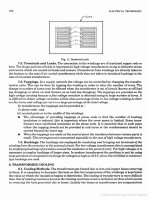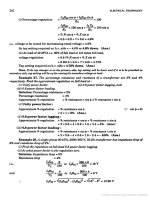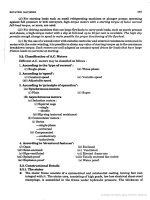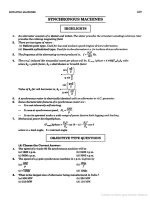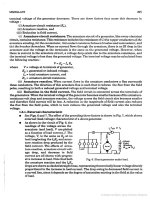Biochemistry Cardiology a textbook
Bạn đang xem bản rút gọn của tài liệu. Xem và tải ngay bản đầy đủ của tài liệu tại đây (1.3 MB, 235 trang )
BIOCHEMISTRY
HIGHER SECONDARY - SECOND YEAR
Untouchability is a sin
Untouchability is a crime
Untouchability is inhuman
TAMIL NADU
TEXT BOOK CORPORATION
College Road, Chennai - 600 006
© Government of Tamilnadu
First Edition - 2005
Chairperson
Dr.D. Sakthisekaran
Professor of Biochemistry, University of Madras,
Taramani Campus, Chennai - 600 113
Reviewers
Dr.P. Samudram
Asst.Prof. of Biochemistry (Retd.)
Institute of Biochemistry
Madras Medical College
Chennai - 600 003
Dr.(Mrs.) C.S. Shyamala Devi
Prof. and Head (Retd.)
Dept.of Biochemistry
University of Madras
Guindy Campus, Chennai -25
Dr.(Mrs.) P. Varalakshmi
Professor & Head, Dept. of Medical Biochemistry
University of Madras, Taramani Campus, Chennai - 600 113
Authors
Dr.(Mrs.) A.Geetha
Reader in Biochemistry
Bharathi Women’s College
Chennai - 600 108.
Thiru. P.N. Venkatesan
P.G.Assistant
Govt. Higher Secondary School
Paradarami, Vellore - 632 603
Dr.(Mrs.) R. Sheela Devi
Lecturer , Dept. of Physiology
University of Madras
Taramani Campus, Chennai -113.
Dr. S. Subramanian
Lecturer, Dept. of Biochemistry
University of Madras
Guindy Campus, Chennai - 25.
Dr. (Mrs.) P. Kalaiselvi
Lecturer, Dept. of Medical Biochemistry
University of Madras, Taramani Campus, Chennai - 600 113
Price : Rs.
This book has been prepared by the Directorate of School
Education on behalf of the Government of Tamilnadu
This book has been printed on 60 GSM Paper
Printed by Offset at:
CONTENTS
Page
1.
Cell Memberane
1
2.
Digestion
27
3.
Carbohydrate Metabolism
43
4.
Protein Metabolism
73
5.
Lipid Metabolism
101
6.
Nucleic acid Metabolism
121
7.
Inborn Errors of Metabolism
143
8.
Biological Oxidation
157
9.
Enzyme Kinetics
179
10.
Immunology
199
11.
Practicals
233
CHAPTER I
Cell Membrane
Introduction
The outer living boundary of the cell is called as the cell membrane
or ‘Plasma membrane’. The term cell membrane was coined by C.J.
Nageli and C. Crammer in 1855. Apart from the cell membrane, each
and every organelle in the cell is also covered by membranes. The cell
membrane not only limits the cell cytosol, but it has a variety of functions
like membrane transport, signal transduction and neuro transmission.
1.1
Chemical Composition
To study the chemical composition of the cell membrane, the
preferred source is RBC, because they lack cell organelles and thus no
contamination of other cellular organelle membranes. The membranes of
the RBCs devoid of cytosol are called as ‘ghosts’.
Four major constituents are present in the cell membrane. They
are (i) lipids (28 – 79%) (ii) proteins (20 – 70%). (iii) oligosaccharides
(only 1 – 5%) and (iv) water (20%).
1.1.1
Lipids
Depending upon the tissue from which the cell membrane is
isolated, the composition also differs. Nearly 80% of the myelin sheath is
made up of lipids, while in liver, it constitutes only 28%.
1
The main lipid components of the membranes are phospholipids,
cholesterol and glycolipids. The major phospholipids present are
phophatidyl choline (lecithin), phophatidyl ethanolamine, phophatidyl serine
and phophatidyl inositol.
Membrane lipids are amphipathic in nature and they have a head
portion, which is hydrophilic and a tail portion which is hydrophobic. As
the membranes are exposed to the hydrophilic environments, the lipids
arrange themselves to form a bilayer in which the hydrophobic core is
buried inside the membrane.
Hydrophilic head
Hydrophobictail
tail
Hydrophobic
CH2COO CH2CH2 CH2 CH2 CH2 CH2 CH2 CH2 (CH2)n CH2CH3
CHCOO CH2CH2 CH2 CH2 CH2 CH2 CH2 CH2 (CH2)n CH2CH3
O
CH2O-P-O- CH2 CH2NH3+
O
Head
-
Tail
Structure of phospholipid
1.1.2
Proteins
All the major functions of the plasma membrane are executed by
the proteins present in the membrane. Proteins account for about 20 –
70% of the membrane depending on the type of the cell. They can be
classified into two types. Integral membrane proteins and peripheral
membrane proteins.
2
Integral Proteins
Some of the membrane proteins are tightly embedded in the
membrane and they cannot be isolated unless, the membrane is
disintegrated. They are called as Integral or Intrinsic membrane proteins.
They are again classified into two. (a). Transmembrane proteins, which
traverse (pass through) or span the membrane. These proteins will have
domains on either side of the membrane. Many cell surface receptors
belong to this class. (b). Lipid anchored proteins that are present either
on the cytosolic side or on the extracytosolic side. They insert themselves
in the membrane by a lipid (acyl chain) attached to the N terminal end.
Transmembrane proteins are of two types. Single pass
transmembrane proteins that traverse the membrane only once. Multipass
transmembrane proteins that traverse the membrane more than once.
NH3+
COOFig. 1.1 Single pass transmembrane Protein
NH3+
COOFig. 1.2 Multipass transmembrane Protein
3
Peripheral Proteins
Those proteins that are present on the surface of the membrane
are called as peripheral proteins. They can be easily isolated from the
membrane. eg. spectrin present in the RBC membrane.
1.2
Models proposed for the plasma membrane
1.2.1
Monolayer Model
Overton was the pioneer to postulate that plasma membrane is a
thin layer of lipid. He proposed this because he found that lipid soluble
substances are easily transported across the membrane.
1.2.2
Lipid Bilayer Model
The amount of lipids present in the erythrocyte membrane was
nearly twice that of its total surface area. This made Gorten and Grendel
to propose that lipids in the membrane exist as bilayers.
Proteins
Lipid bilayer
Fig. 1.3 Lipid bilayer membrane model
1.2.3
Unit Membrane Model
This model was proposed by Davson and Danielli and was shaped
by Robertson. Experiments showed that the surface tension of the biological
membranes are lower than that of the pure lipid bilayers, suggesting the
presence of proteins in them. Based upon this, Davson and Danielli
proposed that proteins are smeared over the lipid bilayer.
4
Proteins
Lipid bilayer
Fig. Unit
1.4 Unit
membrane
Fig. 1.5
membrane
modulmodel
When electron microscope was invented, plasma membrane
appeared as three layers. With this observation, Robertson formulated a
unit membrane model, which states that the proteins are present on either
side of the lipid bilayer. According to this model, the membrane will be
like a lipid layer sandwiched between two protein layers.
1.2.4
Fluid Mosaic model
This is the universally accepted model for plasma membrane. On
the basis of several experiments, S.J. Singer and G.L. Nicolson in 1972
proposed this model.
The essential features of the Fluid mosaic model are
1.
Lipids and proteins are present in a mosaic arrangement within
the bilayer.
2.
Phospholipids act as a fluid matrix, in which some proteins
are integral and others are associated with the surface of the
membrane.
3.
Lipids and proteins are mobile in the membrane.
4.
They can move laterally, rotate but not from one monolayer
to the other.
5.
The membrane is asymmetric in nature, the outer and inner
leaflets of the bilayer differ in composition.
1.3
Membrane Transport
One of the vital functions of the plasma membrane is membrane
transport. Such a transport is important to carry out the life processes of
the cell. Hydrophobic molecules and small polar molecules rapidly diffuse
5
in the membrane. Uncharged large polar molecules and charged
molecules do not diffuse and they need proteins to get transported.
Fig. 1.5 Fluid Mosaic model of cell membrane
Depending upon the energy required and movement of the solute
for or against the concentration gradient, the transport can be classified
into two, active transport and passive transport.
1.3.1
Passive transport
Passive transport is also called as passive diffusion. In passive
transport, the substances move from higher concentrations to lower
concentrations generally without the help of any protein. The transport
6
continues until the concentration of the substance becomes same on both
the sides of the membrane. O2, CO2 and urea can easily diffuse across
the membrane.
1.3.2
Facilitated Diffusion
Eventhough, the concentration of certain hydrophilic substances
like glucose are high across the membrane, they cannot pass through the
membrane and need a carrier for their transport. Such a transport is
called as facilitated diffusion. The proteins involved in such processes are
called as carrier proteins. Carrier proteins are present in all biological
membranes. Some important characteristics of carrier proteins are
1. They facilitate transport from high concentrations of the solute to
low concentrations.
2. They speed up the process of attaining equilibrium
3. They do not need energy for their transport.
4. They are highly specific in nature.
Some common examples are glucose transporter and anion
transporters in red blood cell membranes.
Carrier proteins are classified into three major types.
1. Uniporters that transport single solute from one side of the
membrane to the other.
2. Symporters that transport two different solute molecules
simultaneously in the same direction.
3. Antiporters that transport two different solute molecules in
opposite directions.
7
Uniporter
1.3.3
Symporter
Antiporter
Active transport
Cells have to transport substances against the concentration
gradient, i.e. from low concentrations to high concentrations. This transport
called active transport is a thermodynamically unfavourable reaction.
Hence, it needs energy to drive the reaction which is acquired by ATP
hydrolysis. Active transport is also mediated by carrier proteins and they
are called as pumps. Na+K+ ATPases that is required to maintain the
potassium concentration high inside the cell and sodium concentrations
low is an example for pumps.
1.3.4
Endocytosis
Endocytosis is the active process of engulfing large size particles
of food substances or foreign substances. Depending upon the nature of
the material that is ingested, endocytosis may be classified into two.
Pinocytosis, in which the fluid material is engulfed and phagocytosis,
in which large sized solid material is engulfed.
During the process, the plasma membrane invaginates into tiny
pockets, which draw fluids from the surroundings into the cell. Finally,
these pockets pinch off and are known as pinosomes or phagosomes,
which fuse with lysosomes and liberate their contents into the cell cytosol.
8
Exocytosis is the process of exudating the secretory products
from the cells. Vesicles containing secretory materials fuse with the plasma
membrane and discharge their contents into the exterior. Pancreatic cells
pass out their enzyme secretions to the exterior by exocytosis.
Table 1 Similarities and differences between facilitated diffusion
and active transport
Facilitated Diffusion
Active Transport
1. Needs a carrier protein and
they are named as transporters
or channels.
Needs a carrier protein and they
are named as pumps
2. Highly specific in nature
Highly specific in nature
3. Saturable
.
Saturable
4. Inhibited by competitive
inhibitors
Inhibited by competitive
inhibitors
5. Solutes are transported from
high concentrations to low
concentrations
Solutes are transported from
low concentrations to high
concentrations
6. No energy is needed.
Energy is needed.
1.4
Viscosity
If two tubes, one containing water and the other containing
castor oil are tilted together, the latter will flow slowly, when compared
to the former. This is because of the frictional force that exists between
liquid layers. This resistance for the flow of the liquid is termed as
Viscosity.
9
Viscosity is defined as the internal resistance against the free
flow of a liquid to the frictional forces between the fluid layers moving
over each at different velocities. Each and every liquid has its own
characteristic viscosity co-efficient. The co-efficient of viscosity of a
liquid is defined as the force in dynes required to maintain the streamline
flow of one fluid layer of unit area over another layer of equal area separated
from one another by 1 cm at a rate of 1cm/sec. Viscosity is measured in
poises or millipoises.
1.4.1
Factors affecting viscosity
1. Density
Density and viscosity are directly proportional to each other. They
are related by Stoke’s law. If a small sphere of radius ‘r’ and density ‘ρ’
falls vertically through a liquid with the density ‘ρ’at a steady velocity ‘u’,
inspite of the acceleration due to gravity (g), the co-efficient of viscosity
and density are related as follows.
η =
2r 2 g(ρ − ρ′)
9u
2. Temperature
Temperature and viscosity are inversely related to each other. As
temperature increases, viscosity of the liquid decreases.
3. Solute
Dissolved substances in the pure solvent increases the viscosity of
the solvent. For eg. a protein solution is highly viscous than pure water.
Size and Shape of the solute particles also affect the viscosity of the solution.
10
1.4.2
Biological Applications
1.
Carbohydrate and protein solutions are highly viscous in nature.
2.
Blood plasma has a normal viscosity of 15 – 20 mpoises.
Alterations in the viscosity is an indication of diseased condition.
Viscosity increases during macroglobulinemia, retinal hemorrhages
and congestive heart failure.
3.
Viscosity of blood is 30 – 40 mpoises and is due to the red blood
cells. Viscosity of blood decreases during anemia.
4.
Blood viscosity is useful in streamlining the blood flow.
5.
The lubricating property of the synovial fluid is achieved mainly by
the viscous nature of the mucopolysaccharides present in the
synovial fluid.
1.5
Surface tension
A molecule inside the liquid mass (a) is pulled uniformly on all the
sides by intermolecular forces. But a surface molecule (b) suffers a much
greater intermolecular attraction towards the interior of the liquid than
towards the vapour phase, because fewer molecules are present in the
vapour phase. The excess of inward force on the surface layer accounts
for the surface tension. Surface tension (ϒ) is defined as the force acting
perpendicularly inwards on the surface layer of a liquid to pull its surface
molecules towards the interior of the liquid mass.
1.5.1
Factors affecting surface tension
1.
Density - Macloed’s equation relates surface tension to the density
of the liquid (ρ) and that of its vapour (ρ’).
ϒ ∝ (ρ-ρ')2.
11
(b)
(a)
Fig. 1.6 Unequal force of attraction experienced by a surface
molecule
2.
Temperature- Temperature and surface tension are inversely related
to each other. As the temperature of the liquid increases, the surface
tension decreases and becomes zero at the critical temperature.
3.
Solutes - Solutes that enter the liquid raise the surface tension of the
solvent, while solutes that concentrate on the surface lower the surface
tension.
1.5.2
Biological Importance
1.
Emulsification of fats by bile salts - Bile salts lower the surface
tension of the fat droplets in the duodenum, which aids in digestion
and absorption of lipids.
2.
Surface tension of plasma: The surface tension of plasma is 70
dynes/cm, which is slightly lower than that of water.
3.
Hay’s test for bile salts - The principle of surface tension is used
to check the presence of bile salts in urine. When fine sulphur
12
powder is sprinkled on urine containing bile salts ( as in jaundice),
it sinks due to the surface tension lowering effect of bile salts. If
there are no bile salts in urine as in normal individuals, it floats.
4.
Dipalmitoyl lecithin is a surfactant that is secreted by the lung alveoli,
which reduces the surface tension and prevents the collapse of
lung alveoli during expiration. Certain pre-mature infants have
low levels of this surfactant leading to acute respiratory distress.
1.6
Osmosis
If a protein solution is separated by a semipermeable membrane
from pure water, water tends to flow from the latter to the former. The
property of the movement of solvent particles is called as osmosis. Osmosis
is the net diffusion of water from the dilute solution to the concentrated
solution. Osmosis is a colligative property of solution that depends on the
number of molecules or ions of the solute in the solutions. Osmol units
give the number of osmotically active particles per mole of a solute. Each
mole of a non-ionized solute is equivalent to 1 osmol. Osmolarity of a
solution is its solute concentration in osmols / litre. Osmolality of a solution
is its solute concentrations in osmols/kg of the solvent.
Two solutions with identical osmotic pressures are called as isoosmotic solutions. A solution having lower or higher osmotic pressure
with respect to the other is called as hypo-osmotic or hyperosmotic
solutions respectively.
The plasma membrane is a semipermeable membrane and it allows
only certain solutes to diffuse. The osmotic pressure exhibited by these
impermeable solutes is called as the tonicity of the solution. Tonicity is an
important physiological parameter.
Two solutions with identical tonicities are called as isotonic solutions.
A solution having lower or higher tonicities with respect to the other is
called as hypotonic or hypertonic solutions respectively.
13
1.6.1
Biological Significance
1.
Hemolysis and Crenation. The physiological or isotonic saline is
0.9% NaCl. When red blood cells are suspended in 0.3% NaCl
(hypotonic solution), water will enter into the cells and the cell will
burst releasing all its contents. This kind of lysis is called as
hemolysis. The resulting membranes are called as ghosts. On the
other hand, when the cells are placed in 1.5% NaCl, water comes
out of the cell, leading to shrinkage of cells. The process is called
as crenation.
2.
The erythrocyte fragility test is based upon the osmotic diffusion
property. The ability of the membrane to withstand hypotonic
solution depends upon the integrity of the membrane. Certain
genetic disorders like sickle cell anemia and deficiency of
vitamin E makes the erythrocyte membrane more fragile.
3.
Osmotic pressure of blood is largely due to its mineral ions such
as sodium, potassium, chloride, calcium and protein. The osmotic
pressure exerted by proteins is of considerable biological
significance owing to the impermeability of the plasma membrane
to the colloidal particles.
4.
Absorption of water in the intestine is due to osmosis. Formation
of urine in the kidneys may be attributed to osmotic pressure.
The net difference in the hydrostatic pressure and osmotic pressure
is responsible for the filtration of water at the arterial end of the
capillary and the reabsorption of the same at the venous end. At
the arterial end, the hydrostatic pressure is 22 mmHg and the
osmotic pressure is 15 mm Hg. The pressure to drive out the fluid
is 7 mm Hg. At the venous end, the hydrostatic pressure is 15
mm Hg and osmotic pressure is 7 mm Hg. The net
absorption pressure to draw water back into the capillaries is
15 – 7 = 8 mm Hg. This is called as Starling's hypothesis.
14
5.
The renal excretion of water is regulated partly by the osmotic
pressure exerted by the colloids in the blood plasma. Increased
urination (polyuria) occurring in diabetes patients is due to the
increased water retention by the urinary glucose.
6.
Donnan Membrane Equilibrium
Let us consider two compartments separated by a semi permeable
membrane, which is permeable to water and crystalloids, but not
to colloidal particles. One of the compartment (A) is filled with a
moles of NaCl, and the other compartment (B) is filled with b
moles of NaR, in which R happens to be a non diffusible ion.
(A)
(B)
a
Na+
Na+
b
a
Cl−
R-
b
…1
NaCl diffuses from (A) to (B) and after some time, the system
attains equilibrium. At equilibrium, let us consider that x moles of NaCl
have diffused from (A) to (B). So, the ionic concentration at equilibrium
in both the compartments will be as follows,
(A)
(B)
a-x
Na+
Na+
b+x
a-x
Cl−
R-
b
Cl−
x
...2
At equilibrium, the number of ions that move from one compartment
to other will be equal, and this will occur only, when the ionic products of
the concerned ions are equal.
15
Therefore, [Na+][Cl-] in both the compartments at equilibrium
should be equal.
(a-x) (a-x)
=
(b+x) x
(a-x)2
=
bx +x2
a2 – 2ax + x2
=
bx + x2
a2 – 2ax
=
bx
a2
=
bx + 2ax
a2
=
(b + 2a)x
x
=
a2
( b + 2a )
On substituting numerical values for a and b as 2 and 1 moles
respectively,
x
=
22
1 + (2 × 2)
=
4
5
=
0.8
Calculating the total moles present in compartment (A) and (B) at
equilibrium.
16
(A)
(B)
2 - 0.8 = 1.2
Na+
Na+
1 + 0.8
2 - 0.8 = 1.2
Cl-
R-
1
Cl-
0.8
2.4
3.6
From this we can derive that:
(i)
The concentration of solutes in the non-diffusible ion side (B)
is greater than the other.
(ii)
There will be accumulation of the oppositely charged ion (Na+)
in the side containing the non-diffusible ion (R-).
In biological systems, Donnan membrane equilibrium prevails due to
the non-diffusible proteins and is also significant for the functional aspects
of the cell.
If the non-diffusible ion happens to be R− and one of the diffusible ion
H , then there will be a change in the pH. Due to imbalance in the
electrolytes, swelling of proteins occur, which is called as Donnan osmotic
effect.
+
1.7
Buffers
A buffer may be defined as a solution which resists the change in
pH that will occur on addition of small quantities of acid or base to the
solution. Buffers are mixtures of weak acid and its salt or weak base and
its salt. The pH of the solution is defined as the negative logarithm of
hydrogen ion concentration. The pH of buffers are determined by
Henderson Haselbach equation, which is derived as follows
17
Let us consider a weak acid that ionizes as follows
H+ + A−
HA
Then equilibrium constant K will be
[H + ] [ A − ]
[HA]
Ka =
Rearranging the equation, we get,
Ka [HA] = [H+] [A-]
[H+ ] =
Ka[HA]
[A− ]
Taking log on both the sides,
log [H + ] = log Ka + log
[HA]
[A − ]
Multiplying by -1, we get
− log [H + ] = − log Ka − log
pH
[HA]
[A − ]
[A − ]
= pKa + log
[HA ]
The pH of blood is 7.4 and it should be maintained constant. If
pH increases above 7.5, alkalosis occurs and beyond 7.8 death occurs.
18
If it falls below, 7.3, acidosis occurs and below 7.0 is
incompatible for life. Due to metabolism and dietary intake, large quantities
of acids and bases are produced in the body and they have to be
transported through blood for elimination. This should occur without any
major changes in the pH. This is effectively done in the body by means of
the buffers present in the blood and by two mechanisms, namely the
respiratory mechanism and the renal mechanism.
The buffer systems of blood are as follows
Plasma
Erythrocytes
H2CO3
H2CO3
BHCO3
BHCO3
H.Protein
H.Hb
B.Protein
B.Hb
BH2PO4
H.Hb O2
B2HPO4
B.Hb O2
H.Organic acid
BH2PO4
B.Organic acid
B2HPO4
H.Organic acid
B.Organic acid
The numerators are acid components and the denominators
are salts.
19
Since the concentrations of phosphate and organic acids are low
in plasma, they do not play a major role in regulation of pH.
The major buffer in plasma is bicarbonate buffer and the pKa of
carbonic acid is 6.1. Substituting it in the Henderson Hasselbach equation,
7.4 = 6.1 + log
BHCO 3
H 2CO 3
7.4 − 6.1 = log
BHCO 3
H 2 CO 3
1.3 = log
BHCO3
H 2 CO 3
Since antilog of 1.3 is 20,
BHCO3
20
=
H 2CO3
1
To effectively maintain the pH of blood, according to Henderson
Hasselbach equation, the ratio of bicarbonate to carbonic acid should be
20 : 1. The carbon dioxide produced by metabolism is buffered by the
hemoglobin buffer system as follows.
Hemoglobin buffer system
The buffering capacity of hemoglobin is due to the presence of
imidazole groups in its histidine residues. The degree of dissociation of
the imidazole groups is dependant upon the degree of oxygenation of Hb.
If hemoglobin is oxygenated, it is more acidic and therefore exists in its
dissociated form. When it is not bound with oxygen, it will be in the
reduced form.
20
In the tissues, where oxygen tension is reduced, HbO2 dissociates
to give oxygen to the tissues. In turn, the CO2 produced in the tissues will
combine with H2O to form H2CO3, which dissociates to H+ and HCO3-.
The reduced Hb devoid of O2 combines with H+ ions to form HHb resulting
a very little change in the pH.
When the blood returns to the lungs, O2 tension in the lungs is
high resulting in the oxygenation of Hb. As mentioned earlier, HbO2 has
lesser affinity to H+ and releases it. It combines with HCO3− ions to form
H2CO3 that dissociates to H2O and CO2..
Lungs
Tissues
HCO3-
HCO3HHb
HHb
O2
H+
O2
H2CO3
H+
H2O
H2CO3
H2O
CO2
HbO2
HbO2
CO2
Fig. 1.7 Buffering action of Hemoglobin
21
It has been found that more than 80% of the buffering capacity of
blood is due to red blood cells. But the buffered HCO3− is transported in
the plasma. The process of transport of the formed HCO3− from the
RBCs into the plasma needs chloride ions and the phenomenon is called
as Hamberger’s chloride bicarbonate shift.
When CO2 liberated from the tissues enters the RBC via plasma,
it combines with water to form carbonic acid, the reaction catalysed by an
enzyme called as carbonic anhydrase. The same enzyme can also dissociate
carbonic acid to carbon dioxide and water. Carbonic acid dissociates
into HCO3− and H+ ions.
The formed bicarbonate is exchanged for one chloride ion with
the plasma. The chloride that enters the cell forms neutral potassium
chloride in the cell. The bicarbonate that enters the plasma reacts with the
sodium ions to form sodium bicarbonate. Thus, the bicarbonate ions are
transported in the plasma.
Plasma
Erythrocytes
CO2
CO2
H2O
H2CO3
Band 3 protein
HCO3
H+
KHb
-
HCO3
Cl- + K+
HHb
-
Fig. 1.8 Hambergers Chloride Bicarbonate Shift
22




